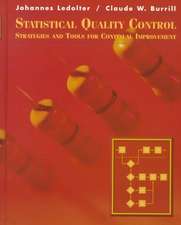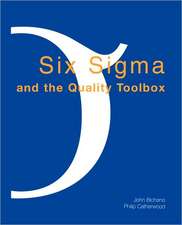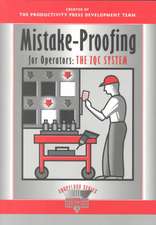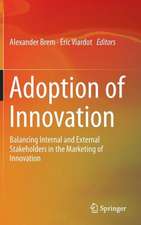Knowledge and Industrial Organization
Editat de Ake E. Andersson Contribuţii de A. E. Anderson Editat de David F. Batten, Charlie Karlssonen Limba Engleză Paperback – 11 feb 2012
Preț: 643.99 lei
Preț vechi: 757.63 lei
-15% Nou
Puncte Express: 966
Preț estimativ în valută:
123.23€ • 128.41$ • 102.03£
123.23€ • 128.41$ • 102.03£
Carte tipărită la comandă
Livrare economică 03-17 aprilie
Preluare comenzi: 021 569.72.76
Specificații
ISBN-13: 9783642955990
ISBN-10: 3642955991
Pagini: 324
Ilustrații: VIII, 310 p.
Dimensiuni: 170 x 242 x 17 mm
Greutate: 0.52 kg
Ediția:Softcover reprint of the original 1st ed. 1989
Editura: Springer Berlin, Heidelberg
Colecția Springer
Locul publicării:Berlin, Heidelberg, Germany
ISBN-10: 3642955991
Pagini: 324
Ilustrații: VIII, 310 p.
Dimensiuni: 170 x 242 x 17 mm
Greutate: 0.52 kg
Ediția:Softcover reprint of the original 1st ed. 1989
Editura: Springer Berlin, Heidelberg
Colecția Springer
Locul publicării:Berlin, Heidelberg, Germany
Public țintă
ResearchDescriere
This volume contains a selection of papers presented at an international symposium on research and development, industrial change and economic policy organized and hosted by the University of Karlstad, Viinnland, Sweden. Situated about halfway between Stockholm and Oslo, Karlstad stands on the River Klara, which reaches north into the mountains of Norway. Founded by King Charles IX of Sweden, whose statue stands in the city centre beside the river, the city celebrated its 400th anniversary in 1984. For many decades the wealth of Karlstad has been based on traditional industries such as iron, timber and paper, and throughout the province of Viinnland there are a considerable number of industrial communities which grew up around mines, ironworks, sawmills and papermills. Even the cultural structure of these communities is heavily marked by the industrial environment in which they developed. However, for over a decade now a major structural reorientation has been taking place and the old industrial structures have been disappearing. For various reasons the importance of large scale, manufacturing companies has declined and as a result of intense development work with new ideas, new entrepreneurs and new technology, we have seen the rapid rise of small companies. In this context, recent research has shown that universities playing an increasingly central role in regional development. Thus the continued development of the University of Karlstad is of significant regional and national interest. Although fairly small in an international perspective (approximately 4000 students) the university is expanding rapidly.
Cuprins
1. From the Industrial Age to the Knowledge Economy.- I. Industrial Organization in the Knowledge Economy.- a) Intelligent Factor Inputs.- 2. Productivity in Manufacturing and the Division of Mental Labor.- 3. What Have We Learned in the Path from Gödel and Turing to Artificial Intelligence?.- b) Knowledge Development and Diffusion.- 4. Knowledge, Nodes and Networks: An Analytical Perspective.- 5. Innovation, Diffusion and Regions.- 6. Technological and Institutional Innovations in the Service Sector.- 7. Research and Development, Corporate Organisation and Industrial Location: Prospects for Regional Development.- 8. Diffusion of Technological Change and Economic Growth.- II. Technological and Economic Interactions: Some Empirical Studies.- a) Long Cycles of Technological Transition.- 9. The Barrier-Breakthrough Model of Innovation and the Life Cycle Model of Industrial Evolution as Applied to the U.S. Electrical Industry.- 10. The Evolution of High Technology in the Boston Region 1920–1980.- 11. Innovation, R and D, and Firm Growth in Robotics: Japan and the United States.- 12. Spatial Diffusion of Information Technology in Sweden.- 13. Innovative Behaviour of Industrial Firms: Results from a Dutch Empirical Study.- 14. Innovating Behaviour of Swiss Industry — Findings and Policy Conclusions.- c) R&D and Property Rights.- 15. Infrastructure for Technological Change: Intellectual Property Rights.- III. The Political Economy of Structural Change.- a) Interdependencies between Industrial and Regional Structural Change in the USA.- 16. High-Technology Location and Worker Mobility in the U.S..- 17. Economic Expansion and Establishment Growth on the Periphery.- 18. The Economic, Industrial, and Regional Consequences of Defence-led Innovation.- b) The Micro-Macro Policy Problem.- 19. Some Reflections on Innovation Stimulating Policy.- 20 New Issues in Science and Technology Policy: Discontinuities in the Process of Knowledge Generation, Knowledge Transfer and Knowledge Transformation.- 21. Micro-Macro Interactions and US Industrial Change.- 22. Swedish Science Policy: The Government’s New Research Bill.- 23. A Ten-Year Review of Science Policy in Sweden.- List of Contributors.









![Using Hoshin Kanri to Improve the Value Stream [With CDROM]: From Theory to Practice](https://i3.books-express.ro/bt/9781420084238/using-hoshin-kanri-to-improve-the-value-stream-with-cdrom.jpg)







